16 June, 2001
Saturday
Monday from 12 noon to Tuesday 12 noon we will do our first diurnal, 24
hours of data collection. There are four of us now. Michelle arrived Friday
night from San Diego. She is a senior at San Diego State U. She'll be here
till mid August working on Glen's project as well as her own. With four people
we will each be taking 6-hour shifts in the field moving around with the
cuvette, pictured below, which will be attached to t he LiCor measuring carbon
fluxes. We carried all the equipment into the field today and spent the day
practicing. Like anything new you learn it seemed complicated at first but
Glen promised that it would become easier as we go. We plan on taking diurnals
once a week from now till the end of the season.
How are measurements taken?
The cuvette is attached to each chamber base with bungee cords. Once a tight
seal is achieved the Li-Cor is attached, by a 1/4-inch clear plastic hose, to
the cuvette and turned on. The Li-Cor instrument will automatically record
measurements. There are 18 chambers, or plots, and measurements have to be
taken six times at each plot with the LiCor, three light measurements (during
the photosynthetic phase) and three dark or covered measurements (during the
respiration phase). The idea is to get as many measurements as possible during
your 6-hour shift moving from plot to plot in an ordered sequence. Each plot
has its own treatment (June 6th journal entry has a diagram of variables at
each plot). The data is recorded and stored in the Li-Cor then dumped into
the computer in the lab. There is always the horror story of erased data
occurring so no data is erased till it is double checked by Glen.
At the same time we are doing this the other two groups (reflectance and
vegetation) will be taking their diurnal measurements. With this coordination
we hopefully will be able to compare and contrast what is going on in the
tundra and get a more complete picture of various processes. Stan, from the
reflectants group, came over with Erika (a student researcher from Kalamazoo
College in Michigan) and was taking light readings at our plot today (picture
below). Their site is close, about 50 yards north east of Glen's, and
slightly higher. You'll notice from the pictures we all have our hoods
up. The day was beautiful and sunny yet the wind was blowing off the ocean and
stronger then it has been. One appreciated the plants' adaptation of
hugging the ground; the lower we were to the ground the more comfortable we
were!
We are lucky being in Barrow because we not only get to do research but we
also get to meet the town’s people and enjoy the Inupiat Culture. This
weekend, and for the following few weekends, the town is celebrating the past
winter's successful whaling season. The whalers were allotted 32 bowhead
whales and the town's whaling crews caught 28. The whaling is done by specific
groups of people, crews, headed by a captain. Each crew is a tight knit group.
Each has their own distinctive flag and the flag is flown on their "umiaks",
seal skin boats, when a whale is caught. Last night, 2 of the many crews had
their celebration, which consisted of the community coming together in an open
area in town and sharing makatuk (whale blubber), cake and each other's
company. Everyone is welcome and the mood is festive and happy. There are
kids everywhere along with teenagers, adults and elders (the older and very
respected people in the community). We arrived about 7pm, sampled the whale
meat and enjoyed the evening that consisted of food, a blanket toss and then
later in the e evening, Inupiat dancing held inside the high school gym.
Everyone wears jeans here along with hiking boots, tennis shoes and weather
proof jackets but last night there were far more people with fur lined parkas
and mukluks (boots) and colorful outerwear. The younger children especially
had traditional outerwear on and the babies were carried on their mother's
back inside their heavy parkas.

The site is looking better and better every day. Glen is testing out the cuvette, the plastic chamber where the actual flux measurements will be taken, and Spring and Michelle (who arrived from San Diego last night) are recording chamber measurements.
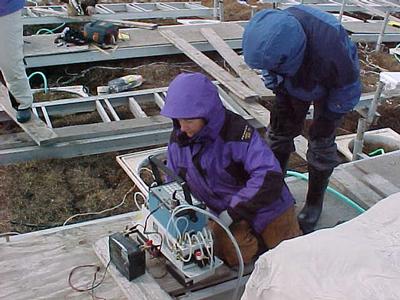
I am using the LiCor, the instrament which we will use to measure gas flux on Monday. In the bottom right hand area of the screen is the cuvette. It is covered to simulate darkness, when plants stop photosynthesising, taking in CO2, and undergo respiration, giving off CO2.
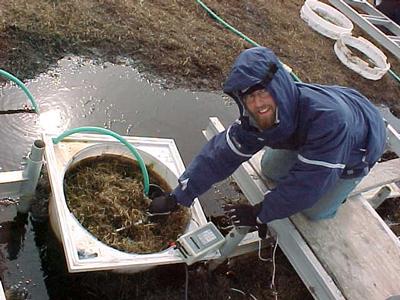
This is Stan who is working at the "rail site" behind our area. He is taking light readings in our chambers; one reading of the light coming down on the vegetation and another reading from the reflection bouncing up from the vegetation.

Close up look at the inside of the cuvette.
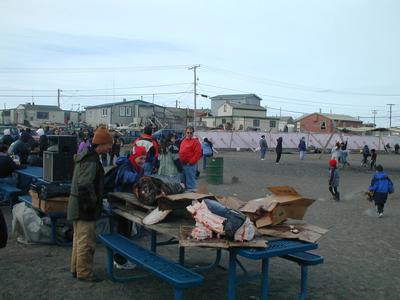
The Malktuk, a celebration of the past winter's whaling successes. The whale bluber is on the table for people to cut off pieces and sample. It's very chewey and has a strong fish taste. Glen and Michelle are trying to decide on just the right piece. To the right you can see kids playing around the stretched seal skin which is used for the blanket toss.
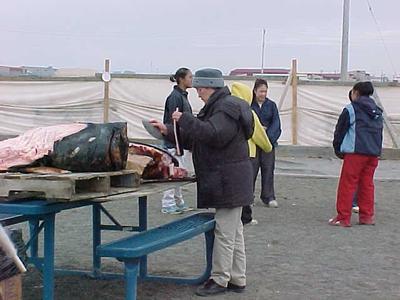
This woman was nice enough to explain to us what part of the blubber was the best. The top inch which has sat out in the sun develops the best flavor. She is cutting off long strips to enjoy.
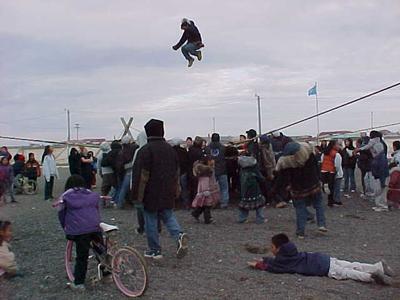
The blanket toss. Anyone can jump and the higher the better.

The whalers who have caught a whale jump and release candy for the children. It's similar to what happens with a pinata, the kids go wild!

Here are some of the kids waiting for the candy.
Contact the TEA in the field at
.
If you cannot connect through your browser, copy the
TEA's e-mail address in the "To:" line of
your favorite e-mail package.
|
